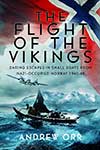|
The Flight of the Vikings
Daring Escapes in small boats from Nazi-Occupied Norway 1940-45
by Dr Andrew Orr

|
Andrew Orr is a friend and so this review should be read in that light. Towards the end of his short time in the RAMC he came in 1978 to be the Medical Officer for 2nd Battalion Scots Guards in Munster, which I was then commanding. He was a great success but after a year or so he decided to resign his commission to go into general practice in Scotland. I well remember asking him why he had decided to leave, and he replied that soldiers were, medically speaking, very fit and presented little professional interest for a doctor, while the generally older population that he would encounter as a GP would offer many greater challenges. And so it proved; not only did he run a very successful practice in Montrose but he also immersed himself in the social life and history of the area, in the process developing a deep interest in the human bonds that has always existed between the people of the East Coast of Scotland and Western Norway.
The Flight of the Vikings has been deeply researched and provides an excellent record of the years from 1940 to 1945 after Norway had been invaded by the forces of Nazi Germany in April 1940. The latter, aided by the traitor, Quisling Vidkun, had crushed all resistance and subjected the Norwegian people to intolerable restrictions and brutal hardships. All this is set out in the book which seeks to document how many Norwegians determined to leave their country to fight with the allies. Scores of fishermen, other seafarers and ordinary people chose to risk a crossing to the Shetland Isles, North East Scotland or further afield, to escape the Germans. They endured many hardships in the process as they navigated the North Sea usually in tiny boats, not always arriving where they intended, beset by severe storms, harried in many cases by enemy aircraft and patrol boats and losing many companions to illness or death by drowning or weather, and not knowing how their families left behind in Norway would be treated by the Germans and their collaborators. Many had to make instant decisions to leave home if they were to reach Britain and there was always the threat of betrayal. Their simple motivation was to join the Allies war effort where many then made a significant contribution to Germany’s eventual defeat.
The sailings made in the early 1940s should not be confused with the Shetland Bus, a small boat service operating out of those islands and run on a regular basis starting in 1942, specifically to ferry arms and other military supplies across the North Sea to the Norwegian Resistance or to rescue those in danger for their lives facing capture or execution if apprehended by the Gestapo. In a way the Bus service grew out of the earlier crossings and benefitted from their experience.
This is a very readable book and will appeal to historians of many shades on both sides of the North Sea and indeed further afield. Andrew writes presciently on page 176 of his book that ‘it is a sad truth that these events, the escapes, the betrayals, the losses and their consequences have largely faded in the memory of twenty-first century Norwegians’. Notwithstanding he has done much to remind us of man’s courage, tenacity, unselfishness and sheer bloody mindedness when faced with injustice and the need to defy autocratic rulers.
Murray Naylor
Pen & Sword
|
|

